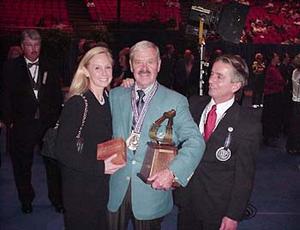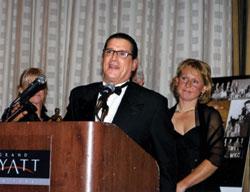Wendell SammetBreeder of the Year
NON-SPORTING: Wendell J. Sammet, Poodles, Ale Kai Kennel Bryantville, Massachusetts Pictured above: Karen LeFrak, 2002 Breeder of the Year Wendall Sammett and Ron Rella. Wendell Sammet has spent over a half-century in purebred dogs. As a teenager, he trained a Dalmatian in obedience, and in 1950 he began breeding them. He finished and bred many champions, but soon found himself in the breed in which he has truly made his mark - Poodles -- establishing a breeding program under the Alekai banner with Mrs. Henry Kaiser. Through the decades, he has prided himself in breeding for health, temperament and breed type. Along the way, he has always found time to serve as a mentor for newcomers to the breed and the sport, as well as an advisor to his peers and in roles for both the Poodle Club of America and the Dalmatian Club of America. The 77-year-old is also a veteran of World War II, having fought at the Battle of the Bulge and being held as a POW for six months. Joseph VergnettiDeveloping a Family of Dogs
By Joseph Vergnetti, as compiled by Arliss Paddock Joseph D. Vergnetti is the top champion-producing Poodle breeder of all time. He has bred all three varieties for more than 30 years, but is best known for his distinctive Dassin line of Miniatures and Standards. He was named 2003 AKC Non-Sporting Group Breeder of the Year and is the Dogs in Review Outstanding Breeder of the Year for 2007. Arliss Paddock is the former managing editor of the AKC Gazette. Breeding dogs must be a passion. A love of dogs, and of the companionship of dogs, must be strong for one to strive toward being a true breeder—to want to create something that tells everyone, “This is my interpretation of what a dog of this breed should look like.” But before beginning toward the goal of breeding your ideal specimen, you must learn all you can. Seek out as many excellent dogs as you can, and become attuned to the finer nuances of the breed. You must see outstanding animals that will leave a lasting imprint in your mind of ideal beauty and balance. You must have a picture in your mind of what is beautiful. As a teenager I apprenticed at Mary Johnston’s Marydane kennel of Great Danes, and there I encountered the first dogs that would give me a permanent impression of that sort. Seeing their elegance and body type cultivated what I look for in a Poodle. I owned and bred Danes of that line for many years, and I remember how similar in style and quality they were to one another. Mary would always say that her dogs all looked alike! I have kept her words in mind ever since, to remember the importance of the fine-tuning of traits that keeps our Dassin Poodles looking alike. Preserving a consistent type over the years is an exciting challenge. As a teenager I also worked with Wendell Sammett and the beautiful Ale Kai Poodles, and saw more gorgeous dogs that left their imprint in my mind. Later I saw my very first Dassin dogs of Bud Dickey’s, and I knew this was the type for me. So, it felt natural to me to eventually mix and match these dogs. Starting a Line How can one begin developing a family of dogs? Ideally, one should start with two quality bitches to breed from. If possible, run on several pups from each litter. We have always done this, usually keeping at least two sisters, and sometimes two brothers as well. Seeing them grow and develop helps you know what you’re going to get when you breed them later on. It’s difficult today for most people to keep a large number of dogs, and puppies don’t always turn out as expected. Thus, for many breeders, the odds are against their always retaining the best ones. Keeping several offspring from each litter is a tremendous undertaking—especially in our case, as we breed all three varieties of Poodle. Properly caring for so many dogs requires a great commitment of staff, kennel space, and time. But it’s a very valuable approach. The larger breeding pool allows you to carefully blend different types and pedigrees within the line for optimum quality. It also helps in the delicate balancing of faults and positive traits; siblings generally produce differently, with some more dominant in certain traits than others. The variety of dogs and bitches available allows the breeder to select the mate that is just right for each. Our kennel situation is wonderful. The puppies are out where they can be seen as we walk to and from the house or go about kennel chores. I love doing the day-to-day chores! Watching the dogs while they’re on their own is a high for me. It’s a chance to see each one as a “total package,” especially the puppies. You see the ones that have the presence and coordination of a ballet dancer—those are the ones you keep, and hopefully they have the gorgeous head and expression that you want. The total package is always the most important thing, but the head is crucial in setting the look that defines your family of dogs. We look for each of our studs and foundation bitches to have a beautiful, finely sculpted head. Keeping a balance of the total package and developing a family to build upon are the goals. But staying with moderation is hard when exaggeration is more eye-catching and easier to achieve. In breeding dogs one must stick to one’s convictions, and not be swayed by fads or excessiveness. It isn’t easy. Each breed has its own trends toward extremes. In Standard Poodles, for example, size is getting out of control. This is a standard sized dog—meaning not big, not a giant! We must try and keep this, and not get to the outer limits. Breeding Strategies In starting out, the challenge can be keeping your line balanced and healthy. There is a lot of trial-and-error involved. You won’t always get what you want or expect from a breeding. You must be willing to regroup, and try again! Sometimes it’s best to look beyond, to the next generation. Maybe what you are striving for will be there. Breeding into different lines, continually seeking new stud dogs, is not the way. This involves too many families, and you’ll never have what you can call your own family of dogs. Linebreed, for the most part; it is the way to keep a type. But whatever the breeding approach, you must take into consideration the dominant traits of each potential sire and dam. Your brain must be like a computer, integrating all of the knowledge you possess about each animal. After a while, you seem to instinctively know who is strong for which traits, and which stud dog is best suited for which dam. It is important to recognize when you might benefit from an outcross breeding. I remember an outcross that Mary Johnston did once that resulted in an excellent litter. She took the best male from this and used him on her linebred bitches, and consistently got what she wanted. That is exactly what we have done at Dassin. We have bred a family of dogs for almost 40 years and have used only two outside stud dogs! We bred to our first outcross, Ch. Eaton Affirmed, in such a way that eventually he was on both sides of the pedigree. We kept brothers and sisters from the breedings, and the result was a very strong family of dogs that brought in the best traits from both families. Then, 15 years later, I bred Ch. Ale Kai Mikimoto on Fifth into our family of dogs. The second I laid eyes on him, I knew he was right for us. I feel that we have had the best of all things from that combination; crossing him with our Dassin bitches seems to always bring out the best. We have bred six bitches to him. Although not a linebred dog himself, Miki was dominant for his outstanding traits when bred to our bitches, consistently producing a beautiful type. We are in the second generation now, and they are what we want. If you’re lucky, you will get that perfect blend from a stud dog. When you outcross, look for a male from a line of distinct type. What traits are strong in his family? What is he dominant for; what does he produce consistently in his progeny? To be useful to you, he must be strong in traits your line needs. Seeing many dogs of your own breed, all the time, helps you to keep your eye keen in this regard. For the Love of Dogs All in all, I think we have bred a similar type in all three Poodle varieties. Trying to achieve this has been great fun. It all comes down to a passion for animals, and for their beauty and companionship. This is what continually feeds your creative eye as a breeder, and your vision of the ideal of your breed. Since I was a child, I’d dreamed of a lifetime involvement with dogs. When I got my first Poodle at age 9, it paved the way for my entire future. People may wonder at all the work involved with what I do, but having bred a beautiful dog always makes me feel like a million bucks. I love living with dogs, and communicating with them. Breeding dogs is, more than anything else, an extension of that love. |






